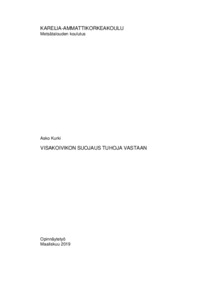Visakoivikon suojaus tuhoja vastaan
Kurki, Asko (2019)
Kurki, Asko
2019
Kaikki oikeudet pidätetään
Julkaisun pysyvä osoite on
https://urn.fi/URN:NBN:fi:amk-201903183324
https://urn.fi/URN:NBN:fi:amk-201903183324
Tiivistelmä
Nykyisin saatavilla olevilla taimilla voi visakoivikoita perustaa korkealla visautumisprosentilla. Metsänhoito visakoivikoissa muistuttaa aikaa vaativan karsinnan takia jalopuumetsikön kasvattamista. Metsänomistajan suurella aikapanoksella saavutetun, kasvavan arvopuuston voi kuitenkin pilata metsätuho. Visakoivun suojaamisessa käytetyistä keinoista ei löydy aikaisempaa tutkimustietoa yhtä Virossa tehtyä tutkimusta lukuun ottamatta.
Opinnäytetyön tutkimusaineisto kerättiin Visaseura ry:n jäseniltä. Vastauksia pyydettiin pahimpia tuhoja kokeneista visakoivikosta. Tulosten perusteella visakoivikon hehtaarikohtainen runkoluku laskee perustamisen jälkeen tuhonaiheuttajien takia 21 %. Saadut vastaukset mukailevat runkoluvun määrän laskussa aiemman tutkimuksen tuloksia.
Saatujen vastausten analysoinnin jälkeen laadittiin toimenpidesuositukset visakoivikon suojaamiseksi tuhoja vastaan. Suositeltavat vähimmäissuojaamistoimenpiteet olisivat heiniminen, kuvion aitaaminen ja myyräsuojien käyttö. Aiheeseen liittyvänä jatkotutkimuksena tarvitaan lisätietoa, mitkä karkoteaineet ehkäisevät jäniseläimien aiheuttamia tuhoja parhaiten.
With currently available seedlings, curly birch stand can be set up at a high rate of figured wood formation. Curly birch forest management resembles growing hardwood grove because of its time consuming pruning. Forest attack can spoil the growing value tree, even if the forest owner would have achieved it by using a lot of time taking care of the grove. There are no previous studies available on the methods used to protect curly birch except for one study that is made in Estonia.
The research material of the thesis has been collected from the members of Visaseura ry. Answers were asked about the worst destructive curly birch groves. The results show that the number of trunks per hectare in the curly birch groves has decreased by 21 per cent since its inception due to various damage factors. The responses received are consistent with the decrease in the number of trunks as in the previous study.
After analyzing the received responses, it was possible to make recommendations for action on how to protect the curly birch groves against damage. The recommended minimum protection measures would be grass control, fencing and using mole shield. As a further research study, more information is needed about which repellents will best prevent hare animals causing damage.
Opinnäytetyön tutkimusaineisto kerättiin Visaseura ry:n jäseniltä. Vastauksia pyydettiin pahimpia tuhoja kokeneista visakoivikosta. Tulosten perusteella visakoivikon hehtaarikohtainen runkoluku laskee perustamisen jälkeen tuhonaiheuttajien takia 21 %. Saadut vastaukset mukailevat runkoluvun määrän laskussa aiemman tutkimuksen tuloksia.
Saatujen vastausten analysoinnin jälkeen laadittiin toimenpidesuositukset visakoivikon suojaamiseksi tuhoja vastaan. Suositeltavat vähimmäissuojaamistoimenpiteet olisivat heiniminen, kuvion aitaaminen ja myyräsuojien käyttö. Aiheeseen liittyvänä jatkotutkimuksena tarvitaan lisätietoa, mitkä karkoteaineet ehkäisevät jäniseläimien aiheuttamia tuhoja parhaiten.
With currently available seedlings, curly birch stand can be set up at a high rate of figured wood formation. Curly birch forest management resembles growing hardwood grove because of its time consuming pruning. Forest attack can spoil the growing value tree, even if the forest owner would have achieved it by using a lot of time taking care of the grove. There are no previous studies available on the methods used to protect curly birch except for one study that is made in Estonia.
The research material of the thesis has been collected from the members of Visaseura ry. Answers were asked about the worst destructive curly birch groves. The results show that the number of trunks per hectare in the curly birch groves has decreased by 21 per cent since its inception due to various damage factors. The responses received are consistent with the decrease in the number of trunks as in the previous study.
After analyzing the received responses, it was possible to make recommendations for action on how to protect the curly birch groves against damage. The recommended minimum protection measures would be grass control, fencing and using mole shield. As a further research study, more information is needed about which repellents will best prevent hare animals causing damage.
